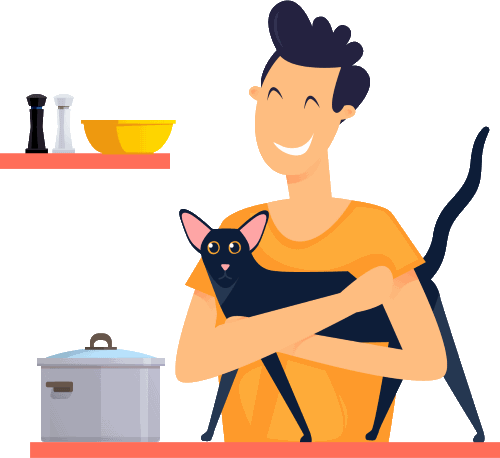
Homemade cat food used to scare me. I was afraid of nutrient imbalances, didn’t know what equipment I needed, and wasn’t ready to spend hours of every month preparing cat food.
The questions were endless.
Are there nutritionally balanced recipes out there or is everyone following the one that “looks like” it makes sense?
Is it okay to give your cat raw food that may contain disease-causing bacteria? Can people of modest financial resources afford to make homemade cat food?
This resource is the result of that research. It’s made for someone who’s considering making their own cat food but doesn’t want to kill their cat by feeding them an imbalanced diet. Maybe that’s you. If so, keep reading to get some answers and maybe a little bit of cat food-making confidence.
By the time you’re done reading this article, you will:
- Know if homemade cat food is right for you.
- Have a better understanding of the differences between homemade and commercially available cat food.
- Be familiar with the different types of homemade cat food.
- Be able to compile a shopping list for your first batch of homemade cat food.
- Have multiple tried-and-true recipes to bookmark or print for future reference.
Why Make Homemade Cat Food?

When you make your own cat food, you control what goes into your cat’s body. You become the cat food manufacturer, so you can do things your way.
Here are a few types of cats and people who can benefit from homemade cat food:
Cats Suffering From Allergies.
Because making your own cat food lets you choose the proteins in your cat’s bowl, homemade cat food is perfect for cats with food allergies. In 2013, DNA testing found that most limited-ingredient or hypoallergenic diets contained proteins that weren’t mentioned on the label. Ironically, the study found that of all the unlabeled ingredients detected in pet foods, chicken was the most common. That’s right—one of the leading cat allergens.
Cats suffering from inflammatory bowel disease, inflammatory bowel syndrome, or a sensitive stomach.
Whether your cat has chronic inflammation or is experiencing acute GI distress, making food at home lets you tailor their diet to work harmoniously with their body.
Remember that while homemade cat food can be a good choice for cats with health problems, no recipe is the right fit for every cat. Cats with chronic kidney disease, for instance, require a unique balance of phosphorus, magnesium, and other dietary components. Not every recipe will satisfy these needs.
Anyone Who’s Frustrated by the Pet Food Industry.
If you’re outdone by constant recalls and can’t find food that meets your standards, then homemade food might be your solution.
Homemade Cat Food Isn’t Perfect, and neither Is Commercial Food.

Homemade cat food can be the greatest gift you’ll ever give your cat or it could be the most harmful thing you can do to them. Most people wouldn’t want to deal with that responsibility. Instead, most of us leave it up to experts to formulate and manufacture our cats’ food.
But the idea that commercial cat food is safer than homemade food is a misnomer. Makers of mass-produced commercial cat food slip up every day. Recalls can hit anyone and they happen all the time, but don’t think that they’re the complete story. If one cat gets sick after eating a bad can of food, who will know?
One day, a production worker drops her gum in the cat food. The next day, someone else doesn’t get the thiamine levels quite right. Human error occurs in food preparation operations on every level.
A Few Examples of Why You Shouldn’t Put Complete Faith in the Pet Food Industry:
Even the sloppiest home food maker wouldn’t fill their cat’s food with melamine-tainted “wheat gluten.”
It’s impossible to know how many cats and dogs died after eating pet food laced with toxic melamine in 2007. Those who remember this mass recall know the feeling of betrayal experienced by pet guardians across North America, Australia, and China. This food was supposed to be safe, fun, and healthy—no one suspected that it would cause acute renal failure.
Cat food manufacturers produced taurine-deficient diets into the late 1980s.
When people warn that deficiencies are common among homemade foods, do they forget that taurine deficiencies weren’t recognized until the late 1970s, long after the pet food industry was well-established and churning out nutritionally inadequate kibble and canned food?
After recognizing taurine’s significance in 1976, the National Research Council’s guidelines were still loose and vague on taurine, allowing more cats to die from heart disease associated with taurine deficiency.
A 1987 article in the Los Angeles Times said that thousands of cat deaths were caused by taurine deficiency. The affected cats ate food from leading brands like Hill’s Science Diet, Purina Cat Chow, 9 Lives, and Fancy Feast.
All Dry Food Is Deficient in Water, but Who Seems to Care?
Your vet may discourage you from making homemade cat food due to its potential to encourage nutritional deficiencies, but how do they feel about the fact that dry cat food is outrageously deficient in water—the most important nutrient of all? Dry food is linked to chronic dehydration and an increased risk of feline lower urinary tract disease.

Commercial Cat Food Contributes to the Feline Obesity Epidemic.
According to Banfield’s State of Pet Health report, the number of overweight cats has increased by 169% in the last 10 years. An estimated one in three cats is obese. That’s not cute. It’s an epidemic.
Feline Obesity/Overweight Over Time
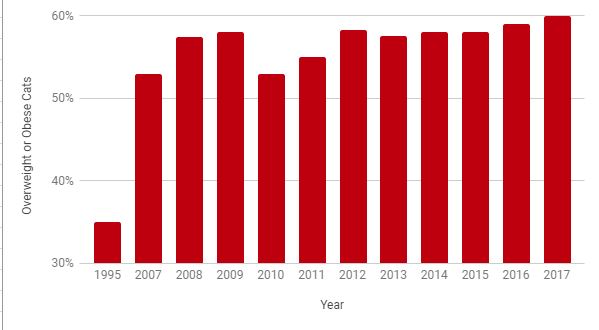
Data sources: Association for Pet Obesity Prevention Surveys 2007-2017, Lund EM (2005): Prevalence and risk factors for obesity in adult cats from private us veterinary practices. International Journal of Applied Research in Veterinary Medicine 3, 88–96.
More cats live indoors than ever before, and they are for the first time in history virtually reliant on humans for food. They barely exercise and they’re loading up on carbohydrate-laden food and treats. When an obligate carnivore with zero physical requirement for sugars or starches eats dry food, their bodies will naturally convert the excess carbohydrate to fat.
Species-appropriate feeding could correct the growing feline diabetes problem.
Dr. Elizabeth Hodgkins, cat nutrition expert and author of “Your Cat: Simple New Secrets to a Longer, Stronger Life” describes feline diabetes as “a human-caused disease that kills cats.” Dry cat food—and some carb-laden canned foods—flood your cat’s system with 500% – 1000% more calories from carbohydrates than they’d eat naturally. A carbohydrate-dense diet may increase your cat’s risk of diabetes and it increases their risk of continuing to suffer from the condition.
Also Read: Feline Diabetes: Diagnosis, Treatment, and Remission Demystified
The ubiquitous “complete and balanced” label means less than you might think it does.
In the United States, cat food is formulated according to the nutrient profiles established by the Association of American Feed Control Officials. These nutrient profiles provide an invaluable guideline for cat food nutritional requirements according to a cat’s life stages (growth & reproduction, adult maintenance), but do not guarantee that the labeled food is nutritionally flawless.
Foods are tested against nutrient profiles or subjected to a 26-week feeding trial. This trial involves eight cats, two of which are permitted to drop out. If, at the end of the trial, the cats haven’t lost more than 15% of their body weight and their cat bloodwork comes back normal, the food is deemed fit for the marketplace.
Clearly, nutritional adequacy over the course of six months is hardly indicative of lifetime nourishment potential. Cats on nutritionally deficient diets can produce healthy blood work until the deficiency has reached a critical stage.
Considering that most pet food regulatory agencies and oversight groups do not account for nutrient bioavailability, nutrient values after cooking, and may not require legitimate feeding trials, there’s no authority ensuring that commercial cat food is appropriate for daily feeding for the life of your cat.
Again, homemade cat food isn’t perfect. But neither is anything on the cat food aisle.
I’ve listed out all of my strong misgivings about commercial cat food, not because commercial food is all bad—it can be very, very good—but to help you see that no food is flawless or completely safe.
Types of Homemade Cat Food
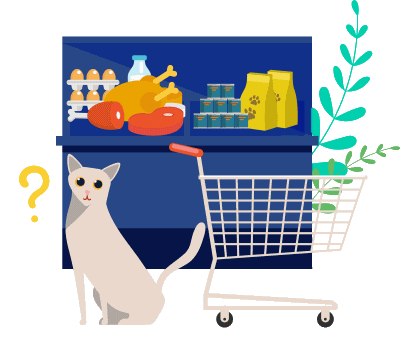
Homemade cat food can be as time-consuming or as simple as you want it to be. You don’t need to have endless free time or be a nutrition expert to prepare food for your cat. You can make cooked food, raw food, or semi-cooked food.
Homemade Raw
This is the most popular type of homemade cat food. It requires minimal supplementation compared to cooked foods. That doesn’t mean that raw food alone is an adequate diet. You’ll still need to add supplements to ensure that the food is nutritionally complete and balanced.
While some express concerns about the potential bacteria content of raw meat, it’s important to remember that your cat’s stomach acid is about 10 times more concentrated than a human’s. Cats have been eating dead animals for thousands of years. This is not to say that a cat cannot get sick from eating raw food, but this does not need to be your #1 concern.
Homemade Semi-Cooked
Semi-cooked food undergoes a brief baking process, which kills surface bacteria and renders the food safer than a purely raw product. It does, however, introduce some nutritional variables. It’s difficult to know exactly how much nutrient value is destroyed during the cooking process.
Homemade Cooked
Homemade cooked food is great for people worried about pathogenic bacteria, parasites, and other organisms that could make them or their cats ill. However, it’s more difficult to get a complete and balanced homemade cooked diet than a raw one.
How Do You Know Your Homemade Cat Food Is Nutritionally Complete and Healthy?
Not all homemade cat food recipes are nutritionally complete, nor are they all balanced. When researchers from the University of California, Davis School of Veterinary Medicine analyzed 200 different homemade dog food recipes in cookbooks and online guides, the team found that 95% lacked at least one key nutrient. Only four of the recipes analyzed were nutritionally complete and balanced.
Also Read: 6 Delicious Homemade Cat Food Recipes (Vet Approved)
To help you to separate bad recipes from good ones, here are a few nutritional rules.
Our cats are genetically almost identical to African wildcats. Unlike dogs, their dietary needs have not evolved from their ancient roots. Indeed, cats have only been eating commercial human-made food for the last century. Prior to that, they ate what they always had—lizards, rodents, birds, and bugs.
After putting together 27 studies on the diet of free-roaming cats, the authors of an article published in the British Journal of Nutrition reached some conclusions about a cat’s dietary requirements.
They found that the macronutrient content of a feral cat’s diet, with essentially no access to human food or garbage, was 52% crude protein, 46% crude fat, and only 2% calories from N-free extract, a term that refers to everything that’s not fat, fiber, or protein.
To help you understand how homemade cat food compares to commercial foods, here’s a comparison chart showing the differences between macronutrient values found in several foods.
What You’ll Need To Make Homemade Cat Food?

Meat Grinder (Optional, but Recommended)
If you are cooking your cat’s food, it is okay to feed them pre-ground meat with supplements mixed in. If you’re feeding it raw, grind it yourself the day you prepare the food.
When most butchers grind meat, they know that the meat will be cooked before anyone eats it. This means that ground meat is held to a low sanitation standard compared to meat ground to eat raw.
Ideally, you’ll use a powerful meat grinder to grind your meat with the bones intact. If you don’t have a grinder strong enough to handle bones, you should either upgrade or use a grinder-free method.
Best Grinder for Homemade Cat Food: Weston Butcher Series #12 Electric Meat Grinder (¾ Hp)
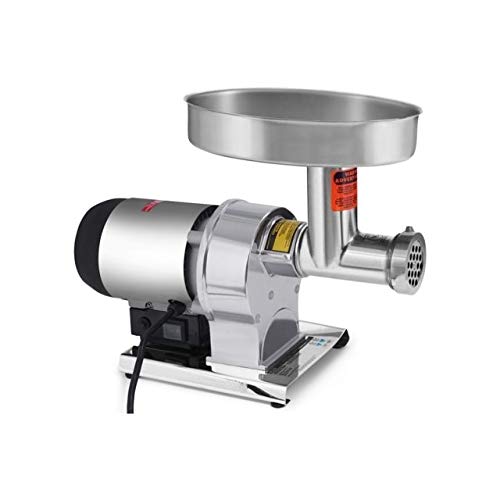
This powerful grinder has enough muscle to handle bones and large quantities of meat. It costs over $500, so if you’re on a tight budget, you might choose the Sunmile SM-G50.
Making Homemade Cat Food Without a Grinder
If you have a Vitamix or equally powerful blender or food processor, you may use it instead of a meat grinder. Other less powerful blenders won’t be able to handle the bones, so don’t risk it.
If you don’t have a Vitamix or a grinder, you can make your cat food without bones.
Instead of taking the ultra-natural approach and grinding the meat and bones together, you can use boneless meat and a bone substitute like bone meal powder or eggshell powder. One route is to use a food processor or blender to grind the boneless meat and organs. While it will take more time, you can also mince the meat with a knife. Here’s a guide to grinding meat by hand.
Whatever method you choose, I recommend leaving a few chunks of meat for your cat to chew and gnaw. This is good for their teeth and, I believe, emotionally nourishing for your cat.
Cutting Board
When dealing with large quantities of raw meat, a large cutting board really makes life more comfortable. Regardless of size, your cutting board should be dishwasher-safe so that you can easily give it a thorough cleaning.
Best Cutting Board for Homemade Cat Food: SMIRLY Plastic Cutting Board Set – Plastic Cutting Boards for Kitchen Dishwasher Safe

After using a small cutting board and constantly worrying about meat sliding onto the counter, I finally invested in this large board. It’s transformed my attitude towards preparing homemade cat food.
Kitchen Scale (Optional)
These allow you to measure out precise amounts of meat and organs, ensuring that the recipe is balanced. You’ll be weighing large amounts of meat, so be sure to get one that can handle at least 10 lbs. If you don’t have a kitchen scale and aren’t prepared to buy one now, you can ask your butcher to measure specific amounts of meat and organs.
Best Kitchen Scale for Homemade Cat Food: Greater Goods 11 lb Kitchen Scale

This economical kitchen scale has an 11 lb capacity, so you can weigh a lot of ingredients with it. Some prefer a scale with a built-in bowl, but I prefer the flat top so that I can pair it with my bowls or storage containers.
Choosing Your Ingredients
Once you’ve gone through your checklist of preparation supplies, it’s time to get your hands on some ingredients.
A cat’s prey is approximately 83% meat, fat, skin, sinew, connective tissue, and heart, with 7% edible bone, 5% liver, and 5% other secreting organs. You’ll need to include muscle meat, bones, organs, and supplements.
Which Type of Meat Is Best?
To reduce your cat’s risk of developing food allergies, feed a rotational diet and don’t become reliant on any one animal protein source.
Chicken
Chicken is an economical, easy-to-find meat. Chicken organs are easy to find in most grocery stores, so there’s no need to seek out a butcher shop or go out of your way to find liver and other organs.
Another nice thing about chicken and poultry, in general, is that it has a high meat-to-bone ratio. Bones are an essential part of a homemade diet, but it’s possible to give your cat too much, resulting in constipation or over-mineralization. The latter can lead to urinary crystals.
Also Read: The 9 Best Chicken Cat Food Formulas
You can use either whole carcasses or parts of the birds. If you choose to buy cuts of poultry, feed about 75% dark meat and 25% white meat. Dark meat has more appropriate fat levels, is more nutrient-dense, and contains more taurine, but white meat has methionine, which can help to prevent feline lower urinary tract disease.
Turkey
Turkey thighs, breast meat, and organs are usually very appetizing to cats and can be a good alternative to chicken for poultry-loving felines. If you can’t find turkey hearts or livers, you can substitute chicken parts.
Also Read: The Best Turkey Cat Food Formulas
Rabbit
What’s great about rabbit is that it’s a natural part of the feline diet. Some domesticated cats kill and eat wild rabbits half their size.
Rabbit is lean and is skinned prior to processing, so you’ll want to add in additional animal fat from poultry or other animals. Remember, also, that rabbit has a higher bone-to-meat ratio than poultry, so you may want to remove some of the bones before preparing rabbit-based homemade cat food.
Also Read: The Best Rabbit Cat Food
Other Options
You can feed your cat almost any type of meat that’s convenient for you. Whenever feeding wild game, it’s important to freeze the meat to kill parasites before preparing your cat’s food.
Meats to Avoid
Don’t feed your cat wild boar, pig, bear, or—if you can get it—walrus meat. These may transmit pseudorabies. Don’t feed your cat squirrel, either, due to the potential for leptospirosis transmission.
Though it’s scrumptious and makes a great snack, ocean fish is contaminated with heavy metals and toxins, making it an inappropriate choice for daily feeding. Cats who consume a raw diet comprised primarily of fish are at risk of thiamine deficiency.
The Importance of Organs and Hearts
Liver
Liver is jam-packed with nutrients. It’s an excellent source of vitamins A and D, along with copper and zinc. Chicken liver is the most commonly available type, but you can get it from almost any other animal. It’s important to note that beef liver has more copper than liver from other animals. If you’re feeding your cat a beef-based diet, be sure to source liver from another species.
Hearts are muscles. They are a key source of taurine.
Hearts are considered to be muscle meat, but in contrast to other types of muscle meat, the heart is rich in taurine. Cats cannot synthesize this amino acid, but it’s essential for good health. Chicken hearts are the easiest types of heart to source, but they’re not as taurine-dense as a mouse heart. For this reason, you can’t rely on hearts alone as a source of taurine. It’s important to add a taurine supplement.
Note that if you’re feeding your cat homemade cat food occasionally to supplement a nutritionally complete product, you don’t need to worry about following a complete and balanced recipe.
If, however, your cat will be eating raw food every day for a week or more, you must follow a good recipe. You can choose from recipes accompanied by a nutritional analysis, which is ideal, or follow one that’s tried and true. Some recipes are neither, and these are the ones you need to avoid.
The following recipes were chosen based on a combination of reputation and apparent quality.
How To Make Homemade Cat Food – With Recipe and Photos
This raw cat food recipe was adapted from one published by the Feline Nutrition Foundation, a non-profit organization led by veterinarians and other people who are passionate about feline nutrition.
The recipe makes enough to feed one cat for about two weeks.
Ingredients
- 2 kg or 4.5 lbs bone-in chicken thighs, with 20-25% of the bone removed OR 4 lbs or 1.3 kg boneless dark poultry meat, ½ of the skin removed
- 200 g or 7 oz raw chicken liver
- 400 g or 14 oz raw chicken hearts
- .24 liter or 8 oz water
- 4 raw egg yolks
- 2000 mg taurine
- 4000 mg salmon oil
- 200 mg vitamin B complex
- 200 IU vitamin E
- 8.4 g or 1 ½ tsp lite salt
- IF USING BONELESS MEAT: 2 ¼ tsp eggshell powder
Instructions
1. Set up your workspace.
Making cat food is so much easier when you’re prepared! I’ve found that covering the workstation with newspaper or another disposable covering is a great way to minimize cleanup time after you’re done making the food.
If you’re particularly worried about bacteria and infection, wear gloves. Remember to change the gloves throughout your process to avoid cross-contamination.
2. Weigh, count, and measure your ingredients.
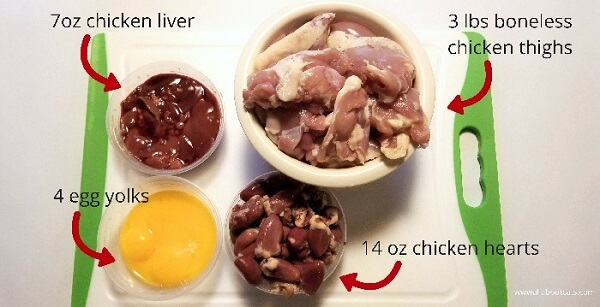
3. Use a sharp knife to chop about a quarter of the muscle meat into chunks.
Chunks give your cat something to chew on, which helps to minimize tartar buildup and encourages good oral health. Start with small chunks or strips and work your way up to larger pieces for your cat to gnaw on.

4. Grind the rest of the muscle meat with the organs.
Again, you have a few options here. Unless you have a very high-powered blender, you’ll need to use a grinder to break down the bones.
You want the bone pieces to be fairly small. Larger bone pieces could puncture and damage the lining of the GI tract. Any bones remaining in the grinder should be discarded.
Those preparing a boneless interpretation of the recipe can use a food processor or blender to break the meat down to a soft, mixable grind.
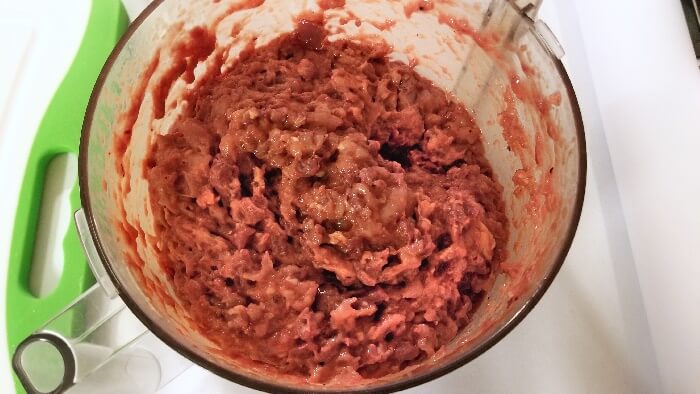
5. Whisk the vitamins, egg yolks, and water together in a medium-sized bowl.
If you’re using boneless meat, this is where you’d mix in the eggshell powder. If you’re grinding in the bones, just use taurine, fish oil, vitamin E, B-complex, and lite salt.

6. Mix everything together in the biggest mixing bowl you own.
This stage can get messy, so choose a huge bowl to minimize spillage. Use a large spoon to incorporate the vitamin slurry gently and thoroughly into the muscle meat and organs. It’s very important to mix well—you don’t want your cat to have one nutritionally deficient meal and another that’s excessively supplemented. The idea is for everything to be fully incorporated for a balanced diet.
7. Transfer the food into your storage containers.
Pull out your storage containers, place them close to the bowl to avoid messiness, and start transferring the finished homemade food into your storage containers. A food scale is helpful here. Without a scale, you’d either have to get your measuring cup dirty or rely on guesswork to give your cat daily portions of raw food.
A food scale allows you to measure the homemade food in the container—no need to wash more dishes or wonder if you’re giving your cat the right amount of food.
8. Freeze what you can’t use within the next 48 hours and then clean up after yourself.
I usually use sanitizing wipes to clean up small messes while I’m working and then use soap and water to thoroughly clean the counter, sink, and any other soiled areas once I’m done. If I’m feeling particularly worried about sanitation, I’ll use a solution of water and bleach on top of everything else.
I realize that many readers won’t want to use these toxic cleaning products around their cats. If you’re worried about your cat ingesting these cleansers, a vinegar and water solution will also work.
Additional Homemade Cat Food Recipe Directory
- Balanced Raw Food Recipe with Nutritional Analysis – Raw Feeding for IBD Cats
- Easy Raw Cat Food – Feline Nutrition Foundation
- Semi-Cooked Homemade Cat Food – Lisa Pierson, DVM
- Balanced Recipe for use with Raw or Cooked Proteins – Raw Feeding for IBD Cats
- Homemade Raw Cat Food Recipe – Cat Nutrition
How Much Homemade Cat Food Should You Feed?
Most adult cats need around 200 calories per day. This usually translates to 6 oz of homemade cat food, but of course, the amounts will vary based on your recipe. The above raw cat food recipe from the Feline Nutrition Foundation contains about 35 calories per ounce.
Also Read: The Complete Feeding Guide From Kittens To Seniors
Feeding Kittens
Ask your veterinarian or a respected veterinary nutritionist to evaluate your homemade diet for kitten-appropriateness. Remember that your kitten’s food requirements are calculated on their predicted adult weight, not their current weight. They’ll need to eat about 5% of their predicted adult weight each day.
Also Read: When Do Kittens Start Eating Food?
Also, kittens have specific nutritional requirements to support healthy growth and development. Your veterinarian or a veterinary nutritionist can help you formulate an appropriate homemade diet for your kitten.
If you think your kitten will grow up to weigh a healthy 10 lbs, they’ll need to eat about 8 oz daily. A large-breed kitten like a young Savannah might need 13 oz or more.
How Much Does Homemade Cat Food Cost?
The answer to this question is extremely variable. It depends on the price of meat where you live, which types of meat you use, and what recipe you rely on.
Here’s a price comparison chart to help you understand how homemade cat food compares to other types of food. All averages were calculated for a 10-lb cat and based on prices in October and November 2018.
Cat Food Daily Feeding Cost Comparison Chart
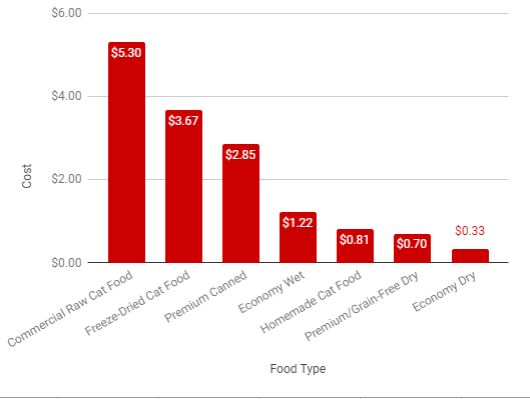
Commercial Raw Cat Food: $5.30
Freeze-Dried Cat Food: $3.67
Premium Canned: $2.85
Economy Wet: $1.22
Homemade Cat Food: $0.81
Premium/Grain-Free Dry: $0.70
Economy Dry: $0.33
Also Read: How Much Does It Cost To Own A Cat In 2022
Surprisingly, homemade cat food is one of the cheapest options in this chart. Granted, this is on the low end of the homemade food price spectrum. By including organic novel proteins, you could easily ratchet the price up closer to the premium end.
There is more than one way to feed your cat a great diet. It doesn’t have to be all raw, all cooked, or even all homemade. And it can change over time.
Don’t feel any pressure to go “all in” right now. There’s no moral dichotomy between raw, cooked, and commercial food. It’s fine to feed your cat a mix of all of those. In fact, feeding your cat a varied diet is a great way to ensure that they remain healthy and adaptable throughout life.
For those afraid they won’t get things right, there are some great options that are less prone to imbalances and human error.
You might use a premix from companies like TCFeline, EZComplete, and Alnutrin.
These supplement blends take some of the fear out of making your cat’s food. Because everything is premeasured for optimal nutrition, the results are always virtually the same, diminishing the potential for deficiencies over time.
Or you might skip the “box cake mix” approach and just opt for a stellar commercial food.
Consider Smalls. This company makes and sells human-grade, homemade-style foods. Just like food you might make at home, each pouch of their food is made to order in small batches from restaurant-quality ingredients.

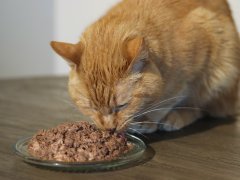

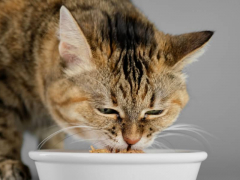



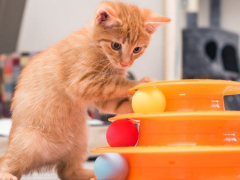
This is very informative. I use TCFeline’s raw premix and just add ground chicken (my cats seem to dislike beef, turkey and even rabbit), raw liver, egg yokes, and water. I also give them Stella and Chewy’s freeze dried food for treats. I must admit I still give them a small amount of dry food because I have a cat that will only eat a small amount of the raw. I have to follow him around with his plate of food but he still only eats less than half of hat the other cats eat.
I don’t understand the vitamin b complex. None of the bottles have the total dosage- it’s all divided up between a bunch of different elements and the denomination never equals 2000mg. Please clarify! ?
*200 mg
Hi Aledo,
That’s a great question. I had the same concern when preparing raw food and ended up calling the supplement company for clarification. The representative explained that a B-100 capsule contains 100mg OR micrograms of each B vitamin (except for folic acid), so you’d use two capsules. A B-50 complex is half that amount.
I realize B-complex vitamins may have slightly different characteristics, so if you really want to be safe, you can use 2 capsules of Natural Factors Hi-Potency B-complex, which is the product used in the raw food recipe on Raw Feeding for IBD Cats. That recipe has been nutritionally analyzed and shown to meet AAFCO guidelines for adult cats.
Sorry that it took me so long to get back to you! Hope this helps to answer your question.
Best,
Mallory
Hi there! I was wondering if I wanted to use a differenttype of egg such as a quail egg that is smaller or a duck egg that is larger 1st off, would those be nutritionally similar and OK to substitute for the chicken egg yolk? And secondly, would I just have to weigh them to get the same amount as the 4 chicken Egg yolks?
Thank you!
Hey Michelle, I wouldn’t use a quail egg as a 1:1 substitute for chicken eggs due to the significantly different nutrient concentrations. Quail eggs are much higher in fat and protein with about double the iron content, so you’ll have to find a recipe that is formulated specifically for the type of egg used.
Thank you so much, this was very helpful!
I don’t understand the vitamin b complex. The bottles don’t have any denominations today 200mg- they’re divided up between a bunch of different elements
I’m confused
How do you defrost the frozen food?
Hello Garrett,
You let it sit in a cool place. A day or two before you’re ready to feed, take a portion of raw food out of the freezer and transfer it to the refrigerator or a bowl of cold water. If you microwave it, you’ll zap away a lot of nutrients. If you leave it sitting out at room temperature, the food could spoil.
Hope this answers your question!
Best,
Mallory
Hi,
I’d also like to add to the frozen food question. Wouldn’t the food still be cold when taken from the fridge? Do cats really enjoy the cold food or wouldn’t they prefer it to be closer to room temperature? I think I’ve tried doing this once and my cats just walked away…
-A
Hi Anais,
You’re right—the food does come out of the fridge cold. My cats eat cool food, but some cats won’t eat it at that temperature. If your cats prefer warmer food, you can put the sealed container in a bowl of hot water for up to 15 minutes before serving.
– Mallory
Ah, great idea! Thank you so much! 🙂
Hello, Mallory Crusta,
It’s so useful recipes for cat!
But, my cat has an allergy to poultry.
So if you have any raw meat recipe without chicken for cat?
Thank you!
HJ
Hello HJ,
Thanks for your comment! Fortunately, there are plenty of solutions for your allergic kitty. The Feline Nutrition Foundation’s Easy Homemade Raw Cat Food recipe has a few variations that explain how to use turkey, duck, rabbit, pre-ground meat, and other protein sources instead of chicken.
Here’s a link to the recipe (scroll down to the section titled “Variations”):
https://feline-nutrition.org/nutrition/making-raw-cat-food-for-do-it-yourselfers
Hope this helps!
– Mallory
I started making my own cat food but I am cooking it. I use a whole chicken cook it, debone it and add the required vitamins and supplements such as taurine and bone meal plus vitamins to the meat once it is at room temperature.
I have determined that my kittens do not like and regurgitate the foods that I make with real liver. They are great with the pre mixes. I really want to follow recipes with whole chickens but don’t know if there is a substitute for the liver. Can I add supplements to substitute the liver? Thank you!
Hi Anne,
Good question. While it’s not a long-term solution, CatNutrition.org says that you can temporarily use a mix of synthetic vitamin A and D instead of real liver. Again, you’ll ultimately want to use liver to avoid copper and zinc deficiencies over time. The recipe from Cat Nutrition recommends the following substitution for 400 grams of liver:
“If you can’t find appropriate liver, you can TEMPORARILY and for short-term use only substitute 40,000 IU of Vitamin A and 1600 IU of Vitamin D.”
Click here for more details and the full recipe: http://www.catnutrition.org/recipes.html
Since your kittens seem to tolerate the freeze-dried liver found in the cat food premix, you may be able to substitute liver powder for fresh liver in a recipe that uses whole chicken. That said, I’ve not been able to find instructions on making this substitution. You may want to contact the makers of TCFeline or your premix of choice for more insights.
Hope this helps!
Best,
Mallory
I’m interested in this recipe, but I would rather do both vitamins than pills and capsules. Like for example the salmon oil you can buy it by the bottle for pets. The recipe has it for pills. How do I figure out how many squirts of salmon oil I need for a batch of food?
Hi Amanda,
That’s a good question—the oil in a bottle is definitely easier to handle than salmon oil in capsules. Though specifics vary from product to product, most fish oil has about 1,000 mg per teaspoon, so you can add four teaspoons of oil to the recipe. How d does that convert to pumps and squirts? Again, it really depends on the product you buy and most bottles will give you the information you need.
The same conversion applies to any of the other items here. You’ll need to find out how many micrograms or milligrams of the key nutrient exist within your given measurement system and make the conversion accordingly.
Hope this helps!
Best,
Mallory
For those asking about substituting liver, here is a resource:
rawfeedingforibdcats.org/using-freeze-dried-liver-in-place-of-fresh.html
Basically, just make sure you buy something that is 100% liver. Then convert the amount based on how much moisture is in the fresh liver that you buy.
so would topping some kibble with raw chicken heart and or liver be a good thing or a bad thing?
It would be a good thing if done occasionally! Obviously, you’ll have to feed a bit less kibble to keep calories under control and pay a bit more attention to the storage of the food to make sure that nothing goes bad. But other than that, adding raw meat and organs to dry food is a great way to make your cat’s diet a little bit richer. I wouldn’t do it every day, but if done a couple of times a week, it is a good complement to your cat’s normal diet.
If you please recommend me raw diet recipe for Hyperthyroidism cat please? Most of recipe need to add Salmond oil and I am wondering if cat with hyperthyroidism would be ok with it ? And if all of supplements on the cooking lists are ok for hyperthyroidism cat
Hi Paria, if your cat has untreated hyperthyroidism, I would not recommend using any non-prescription diet as treatment. That being said, if your cat is being treated and you just want to give them a nutritious diet without too much iodine, I think this or any trusted recipe would work. Salmon oil isn’t particularly high in iodine and should be safe for cats with hyperthyroidism.
Thank you for such a detailed article! I have previously attempted making cat food from chicken, time to give turkey a try.
Good luck with the turkey recipe! Thanks for stopping by.
Hello, I would like to start raw-feeding my adult maine coon, I believe that she is allergic to chicken since she has been eating it her entire life as dry kibble (Go!, Orijen while it was still Canadian and the new Orijen from Kentucky). My cat presented sneezing and otitis in May, which I thought were caused by mites but a vet found none and linked her condition to either an environmental or food allergy.
After removing potential allergens (like detergents) and switching my cat to Oven Baked Tradition Duck recipe the ear discharge first reduced and then disappeared, but it is only a temporary solution since this kibble is very high in carbs and contains peas as a third ingredient. I live in Chile so I am unfortunately very limited in my choices, nearly all the kibbles available here are exclusively chicken-based.
I am excited about the raw recipe based on rabbit, but I am concerned with the effects of chicken hearts and livers. Is there any way I can substitute them without seriously offsetting the careful nutritional balance of raw recipe presented by The Feline Foundation? I’ve checked the nutritional difference between chicken liver and turkey liver and discovered that turkey liver has gigantic Vitamin A levels that are 6 or 7 times greater than those of chicken liver. If my cat is sensitive to chicken muscle meat (highly likely), does it also mean that it will be sensitive to its by-products even if they are roughly 1/4 or less of the entire mass of raw recipe? If yes, what kind of alternative do I have without bringing serious alterations to the needed levels of taurine, Vitamin A and other essential components? Also, rabbit since rabbit is considered lean meat how can I make sure that my pet gets adecuate levels of fat?
Thank you
Hello Mark, that’s an excellent question! Unfortunately, I haven’t been able to find any answers for you; there are recipes using whole rabbit (which would rely on the rabbit organs rather than those from any other animal), but I haven’t found anything that would pair well with rabbit muscle meat alone. The people at Raw Feeding for IBD Cats are very experienced with raw cat food and may be able to help you out: http://www.rawfeedingforibdcats.org/
Hope you find a recipe that works for you and your Maine Coon soon!
– Mallory
I will share my thoughts on this chicken allergy business. Its not the actual chicken . There is something the chickens are eating/drinking, being admiinstered or are exposed to that the cats are reacting to. What are the laws in Chili regarding antibiotic/hormone injections? It is just abnormal for a cat to be allergic to protein. Same with humans & peanuts. Its not the peanuts. Cottonseed oil is an ingredient in an antifungal used to keep stored crops from getting mold. There is a connecrion. Good luck.
My male Maine Coon cat has been prescribed a medicated food ( Urinary SO by RoyalCanin) for his continued issue with crystals in his urine causing blockage. They said he must be on this for the remainder of his life. Wondering though if there is anything natural that he could have as the medicated food long term is definitely going to cause issues as well.
Hello there, thank you for asking! That’s an excellent question. You might appreciate the recommendations in our article on the best cat food for urinary tract health. https://cats.com/best-cat-food-urinary-tract-health
I am feeding my 3 cats a diet purchased from a well respected raw food provider. Their formula for chicken is 80/10/10. The 10% organ they say is all liver. My question is this too high a ratio of bone and is the liver content too high? I have been adding boneless meat chunks to get a 86/7/7 results because of my concern for the high bone and liver. I do add Alnutrin, taurine, digestive enzymes, probiotics and krill oil. My concern is their stools are too soft. I do not know how to adjust this! Also one cat passes large amounts of hair coated with soft poo. Please help. Other than the poop issue my cats a very active and have no other issues.
Hi Donna, those ratios are generally recommended for raw cat food and it’s common for liver to be the only organ meat in a raw food recipe. There is a chance that your cats’ stools are too soft due to excessive fat intake or the fiber in the additives you’re providing. I would suggest consulting a qualified veterinarian or veterinary nutritionist for further advice.
THanks for all the great info.
I have a rescue cat. She is about 2 Year she old. She came to us on a prescription dry food diet for digestive issues and skin issues. Her coat was rough and patchy. She had dandruff. I started her on a diet from catinfo.org, which is very similar to what you have here. I am very hesitant to do raw, as I suffered severe salmonella from undercooked chicken. I have learned that those with compromised gut health are more prone to food poisoning. Since my kitty seems to have compromised gut health, and recently was severely ill from something she ate (she is a hunter and goes outside), I do not want to do raw. I also cannot afford a grinder. I have been cooking the chicken. Then I make a bone broth and use some of the bones, cartilage and broth and grind it up in a food processor and add it to the chicken and supplements. All the raw food sites warn that cooking the food changes the nutrition, but all the recipes I can find for cooked food contain grains and vegetables! She is doing great. Her coat is full and sleek. She is playful and has a good appetite (maybe too good). But I am still concerned that I may not have the balance of nutrients right because of the warnings that nutrients are lost in the cooking process. Any wisdom you could provide would be very much appreciated. Thank you!
Hi Mallory , you are so funny “cats have been eating dead animals for thousands of years”. That tickled me funny bone since it seems the answer to the raw food question should be clear as a bell to anyone.
My thoughts on cats being allergic to chicken; it isnt the inherent chicken-ness. It is something being administered to the chickens, something the chickens are eating or that they are exposed to (insecticide/pesticide, fertilizer, whats in the water, who knows?)
Thanks for your efforts in researching this, much appreciated
Thanks for chiming in, Alice! I’m glad you appreciated that line. 🙂
“clear as a bell”? Maybe not. Since raw cat food recipes generally try to mimic the nutritional value of a whole mouse, and “cats have been eating dead animals for thousands of years”, the obvious answer to me would be to feed them dead mice. Is that what you were thinking? I doubt that mice would be very expensive (dead or alive) and they’re fed to snakes, and what could be easier? But I’ve never seen that suggestion for cats.
Well, I discovered that dead frozen mice are VERY expensive. Like twice the price of sirloin steak. I can’t imagine how raising mice could cost more than cattle, but ……. nevermind!
Hi Mallory, I had a question on supplements. Ive decided to get premade meat/bones/organs mix from a company then add the Alnutrin premade supplement. Now, on the Alnutrin website they specify not to use it with any additional supplements. Looking on the feline nutrition website they say it’s optional to add psyllium husk powder if my fur kids have been eating kibble for a while to help with the fiber intake There is no psyllium husk power in the Alnutrin. Would it be safe to use some in my cat food mix? Is it worth adding? Thanks in advance!
Hello Christina, thank you for reaching out. That’s a good question! Psyllium husk powder is a source of prebiotic fiber and will not throw off the nutrient balance of your cat’s food. I see nothing wrong with adding it to your cat’s food along with the Alnutrin. If you’re still uncertain, please feel free to contact Alnutrin and ask about it directly. – Mallory
I have been making raw food for my cat for over 10 years. The formula I use is 5% liver, 10% bone (chicken necks, back bones and wingettes), 10% other organ meat (a chicken heart in every portion) and 75% meat which consists of chicken thighs and pork (I used to use beef but it’s just too expensive). I make it 3 times a year since it is labor intensive and freeze it in 7 oz baggies (her daily portion for her size); each bag has the above ratio. I keep a couple of baggies thawing in the frig every day then before bed I set her daily portion on a plate and she eats it during the night. I assume she eats it when it reaches a temperature she likes. In the beginning I was nervous about her getting the proper nutrition but every time I took her to the vet and had a blood workup she’s been fine. The vet says to keep doing what I’m doing because she is so healthy – silky coat, bright eyes, clean teeth, strong heart and normal bowels.
My question is: why grind the meat and bones? I have never done that and I believe that is why my cat’s teeth are so healthy; she tears the meat and chews the bones. This is how cats eat in the wild. Bones are safe as long as they are small and not cooked. We have never had a health issue with her.
Hi Jodi, that’s a good question. I think the bones are generally ground to make sure that everything gets mixed together and the ingredients are properly distributed. Without grinding the bones together with the other ingredients, I’d imagine you’d get some clumps of meat, connective tissue, and bone that are not mixed up with the other ingredients. However, if it’s working for you—as seems to be the case—I see no reason to change your approach.
Her plate is clean every morning. She eats everything – bones and all. Do you think that is better for their dental health?
Jodi,
I like your solution. Do you know approximately how much this food costs (the ready to eat product), per pound or ounce? I feed many cats, so price is an important consideration for me. Thank you.
Could turkey liver and heart be used instead of chicken?
In general, it seems that turkey makes a decent 1:1 substitute for chicken. However, one thing to note is that turkey liver seems to have a higher concentration of vitamin A, as demonstrated by this cat food maker’s experience. I’m not a veterinary nutritionist and can’t give any definite advice, but I would think that turkey should be an acceptable substitute for chicken on occasion, but you will want to be careful to ensure that your cat isn’t getting too much of this vitamin. Consultation with an expert in feline nutrition and food formulation may also be beneficial.
I make homemade cook food for my cat, but i’ve been skipping the suplements becuse i thought they weren’t necessary since i was complementing with kibble, but now i know i shouldn’t have. My question is, can i give human intended supplements (the ones u can get at a drugstore) for my cat? Since i live in Panamá is very difficult and almost impossible to get pets intended supplements.
As long as you’re able to find all of the supplements listed in the recipe, drugstore vitamins, minerals, amino acids, and fatty acids will work. Living in the United States, I also don’t find a lot of pet-intended supplements outside of certain supplements and blends like omega-3 fatty acids. Many, if not most, raw feeders will use human-oriented supplements for their cats. Wishing you all the best!
Mallory,
To clarify, do you buy vitamin supplements intended for humans and use the amount in the recipe?
Also
I saw a recipe with rabbit…. where do people buy rabbit?
Yes, exactly! All of the amounts listed are for “human” supplements. You can purchase rabbit from a company like Hare Today, which specializes in fresh meats for raw feeders.
I’m new to this website, and I think that it is a great idea, with the most new and comprehensive thinking I’ve seen. I really appreciate this discussion of simulation of natural diet. There are just two things missing, unless I’ve missed something:
1) You left out a very crucial step: Before you make up pounds of raw meat mixture, or even cooked mixture, TEST your cat on real food. I’ve been down this road before. They eat the tuna cat food, but when you give them REAL tuna, they say, “What is this crap?” They devour the chicken cat food, but when you give them real chicken, they repeat the tuna response. Ditto for the Thanksgiving turkey, even though they were standing around you the whole time you were preparing it, begging for handouts. I’ve boughten a big bag of frozen ground whole raw rabbit, only having to give it to the raccoons. You may have to cultivate a test for the REAL food, especially the raw foods, before they go in on it (and good luck in getting them to change their tastes). A lot of the rescue cats that I’ve had have never eaten anything but dry food. They go their whole lives without even accepting canned food. So, there is a lot to be said for cultivating tastes. Even a huge percentage of humans do not know natural food. By the way, same for the dogs.
2) I wish you had discussed Vitamin C. Yes, the dominant paradigm is that they make their own Vitamin C, so they don’t need it. However, there are always problems with dominant paradigms, and all of them are present with this one. First of all, natural foods for cats (i.e., fresh, live, raw meat) are not devoid of Vitamin C. Even the early 20th-century arctic explorers knew that they could prevent scurvy by eating raw flesh from seabirds. The same is true for a host of other nutrients which are present in raw food (plants and animals), but destroyed by cooking, including MSM, chondroitin, glucosamine, and other nutrients, including enzymes. Human (alternative) nutritionists and physicians who study joint health refer to arthritis, for example, refer to osteoarthritis as “cooked food disease”. I think that cats on the dominant paradigm diet are on a deficiency diet, deprived of a whole population of nutrients. Specific to Vitamin C, I estimate that there is not much known about a cat’s capacity to produce its own VC, especially as it ages. When it is confined to a cooked, processed-food diet, and if its capacity to produce VC declines, it probably is suffering from a deficiency of VC. I am struck by the similarity in cats between old age symptoms and scurvy–the way they begin to lose teeth, for example. I’m leery of adding artificial VC to a cat’s diet; but I’ve tried to introduce natural VC and other phytonutrients to cats’ diets by adding a little bit of a green smoothie to their canned food (the key is “not too much”, or they will reject it). Before you decry my alleged “hippie” or “irresponsible” practice, recall that cats naturally eat herbivores, and those herbivores have plant material in their gut, and the cats eat the gut, too. The green smoothie is high in phytonutrients, and negligible in carbs. Therefore, part of a live, fresh, raw meat diet is eating what they eat. Animal keepers across the board who study natural nutrition of predators know that “They eat what they eat”.
I am struck how lifespans in cats are so short. I constantly wonder if that is necessarily a consequence of the obligate carnivore diet; or, if we provided our cats a more natural diet, we would also be providing a longer and better life.
This is really helpful, CH! An excellent recommendation about testing whole proteins with your cats before committing to a full homemade recipe. We all know how finicky cats can be – you never quite know what they’ll turn up their noses to!
And really interesting information about vitamin C! It’s a good point that there’s probably a lot we don’t know about how cats produce this particular nutrient and the differences between raw and cooked food in this area. I don’t see anything wrong with using whole foods as a natural source of vitamin C for your cats versus a supplement. Especially given that you’re doing it in the form of a smoothie which has already been blended – it may be easier for cats to digest than whole plant foods.
Thanks again for the info, I’m sure other readers will find it informative!
My 10 year old cat has to eat urinary tract care cat food, but has also developed a kind of dermatitis itchy scabs all over his body and it is possibly from a food allergy. It seemed to have started after he was switched to the urinary food. My vet recommended Hydrolyzed protein food with S/O index for urinary tract care. I have old found one brand that makes this combination of cat food Royal Canin and in only one flavor. My cat doesn’t like it even if I make it soft in water!:(
Could I feed my cat this homemade diet with out bones possibly?? I am not totally understanding hydrolyzed protein or S/O index food.
But I am desperate to find a food he can eat and maybe enjoy a little. Thank you
Hello Rosie, it sounds like your cat is having an allergic reaction to the urinary care food, so your vet has advised feeding a hydrolyzed diet. In a hydrolyzed diet, all of the proteins have been broken down so they can’t trigger a histamine (allergic) response in the cat’s body. The S/O index means that the food is formulated in a way that will discourage the development of urinary crystals (both struvite and calcium oxalate). I believe a homemade diet could be a good match for your cat, but I would keep careful notes to see how he reacts to it, sticking only to single-protein recipes to help you get a handle on which ingredients are triggering this reaction. Hope this helps!
Hi I give my cats organic can chicken. Is this bad for them?
Perfectly fine as a treat, but it’s not a nutritionally complete diet.
I have a 11 yr old with early stage kidney disease, chronic pancreatitis, newly developed chin acne(?) and arthritis. She is intensely picky and wont eat ANY of the prescription foods we have tried. We are in a testing period trying several different foods including Smalls, Simple Food Project freeze-dried raw and others. She has recently developed a constant nausea and without apatite stimulant, wont eat period! Our daily routine includes; Gabapentin for pain (monthly Solensia), Mirataz stimulant, Ondansetron anti-nausea, and bi-weekly Vit. B12 injections. My life is nuts with her to say the least. The EATING thing is the worst of it. She has an ultrasound in a couple weeks to find out the cause of the nausea. Please send me links / info on FEEDING homemade partially cooked/raw for her. We also have a 7 month old kitten in the home and an 8 week old MC kitten being brought home soon. I could use some guidance on feeing this wide range of needs!
Hey there. Sounds like you’re going through a lot! You might appreciate our article on the best homemade cat food for kidney disease. Hope this helps, and I wish you all the best.
What can you use when you can’t get chicken hearts. I can mostly get chicken livers and gizzards but my cats don’t like the gizzards when I use them. Also is there a one stop mixture of additives. Right now I have to measure out a selection of additive’s. I started making my own food 6 months ago and now some of my 5 cats won’t eat anything else. i am trapped into making this food every two weeks.
Hi Rosemary, it’s recommended that without heart, you can substitute with added taurine. This video offers some guidance.